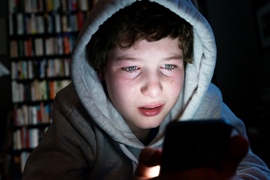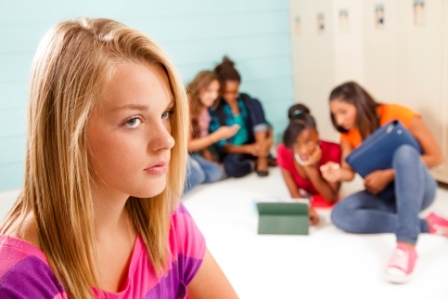
Cyberbullying can look different to different people. At times, youth may not even call the behaviours cyberbullying, and use words like 'drama' to describe what they are experiencing online. Talking with them in their own terms and on their level helps to better understand what is taking place, and what supportive steps to take next.
In some instances, cyberbullying is against the law, and can result in criminal charges against the offender of the bullying, something many adults and kids may not know.
What does cyberbullying look like?
The Royal Canadian Mounted Police defines cyberbullying as using the internet, social networking sites, websites, mails, texting, instant messaging, and other means of electronic communication to repeatedly intimidate or harass others.
Some examples include:
- Sending mean and threatening texts, emails, or instant messages;
- Posting embarrassing pictures of someone online; and
- Creating a group, website, or chat with the intent of making fun of others.
Every case of cyberbullying is as unique as the people involved. Youth of all ages and backgrounds have the potential to experience cyberbullying, however, some experience increased vulnerability due to their other overlapping identities. Youth who are Black, Indigenous or a Person of Colour, youth belonging to the 2SLGBTQIA+ community, and youth with Disabilities experience added discrimination online.
What are the impacts of cyberbullying?
People who are cyberbullied react in different ways, there is no 'right' or 'wrong' way to react. Some youth feel lonely, isolated, depressed, anxious, or aggress out. Just like other forms of violence, cyberbullying can have long lasting impacts on a person's self-esteem and sense of safety.
How can I help?
There are some things you can do and some advice you can share with your child that may help, including:
- Let them know it is not their fault. No one deserve to be treated cruelly.
- Don't respond or retaliate. Sometimes a response is what the bully wants, and retaliating turns you into a bully.
- Save the evidence. Save text messages, and screen grab mean comments and other online evidence of bullying in case it escalates.
- Tell the bully to stop. This may not be something your child feels comfortable doing, and that is OK.
- Reach out for help. Tell your child to reach out to someone for help, even if that isn't you.
- Use technology to help. Block the person on social media, from texting, and from calling, and report the behaviour to the service. It may not stop the harassment but it won't be in your face. If there are threats of physical harm, report it to police.
- Protect your accounts. Don't share passwords
- If you see bullying, take action. Don't stand by. If a friend is being bullied, talk to them and encourage them to ask for help.
Tips courtesy of ConnectSafely
What if my youth is cyberbullying others?
It is important to consider what needs are being met by engaging in harmful bullying behaviours online. Beneath the surface, this behaviour may be meeting a need for power and control, a need for connection or approval from others who are also bullying.
Some other reasons why kids may cyberbully:
- Cyberbullying is often a way to relieve boredom, and a way to inject excitement and drama into their lives.
- They believe the victim deserves it.
- They don't feel good about themselves or they are dealing with something in their own lives that is out of their control.
- They feel a sense of invincibility online, and believe they won't get caught.
Tips courtesy Public Safety Canada
What can I do?
- Monitor screen time and device use more carefully.
- Talk with them in a non-judgmental way.
- Let them know they are safe and that they can share with you or another trusted adult.
- Talk with them about the impacts of cyberbullying on the victim and the possible consequences for someone who is cyberbullying.
- Encourage them to share with you why they are cyberbullying others, what other issues could be contributing to their actions, and, together, discuss what you can do to stop it from continuing.
- Educate yourself on social media, including the sites and apps your kid is using. Encourage them to remove hurtful messages, photos, videos, etc.; encourage them to spend less time with friends who may be engaging in cyberbullying; talk with them about apologizing to the person or people they cyberbullied.
If outside authorities such as the school are involved, encourage cooperation while letting them know you will be there to support them throughout the process. Learn the legal consequences of cyberbullying, and discuss them with your youth. Seek outside professional help. There may be other issues contributing to the cyberbullying that may need to be addressed.
What not to do if your kid is cyberbullying
- Don't 'freak out' on your child. Talk with other adults to work through your anger and hurt.
- Don't try to deny the situation or find someone to blame. Your child needs you as a guide and role model, and acknowledging the damage they have done is important.
- Blaming 'those new friends' or 'the kid next door' may have truth, but you need to help your child see their role.
- If your child was cyberbullying as a reaction to being bullied it doesn't justify their own hurtful actions.
- Be careful not to assume your child 'could never do something like that'.
Tips courtesy Public Safety Canada
